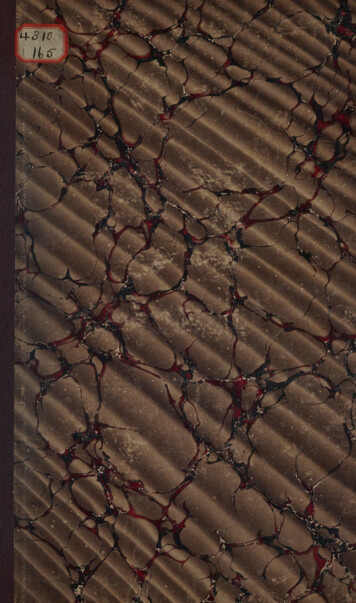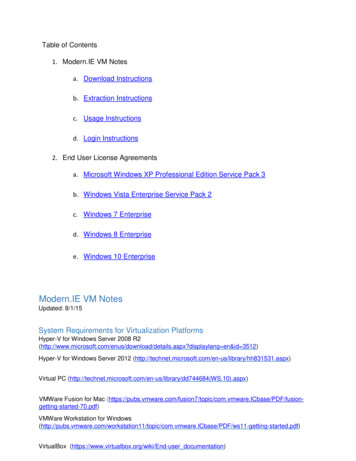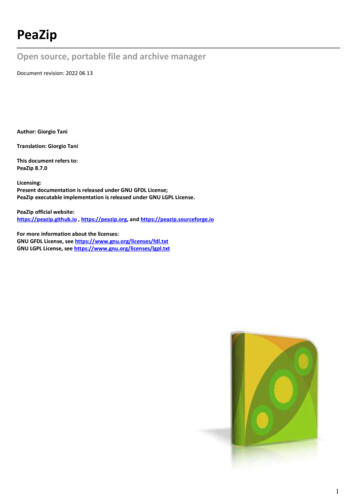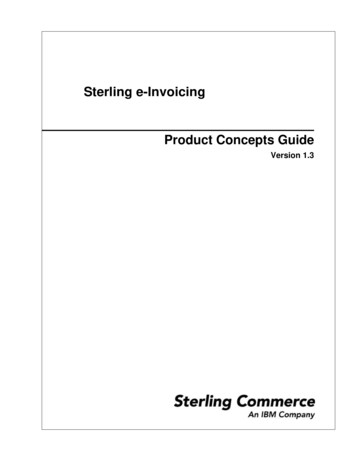
Transcription
iBOSTONIAgf
dl& oo! 7 peedaSirtckesveBal };vtmn iyalr* abe%eS p vdavieenieneed aekeraas,makche
ua»*tL):7oy oa eea 4«@"anegfa?%«ny.beoeI.a74:\4‘Sul*Vis, ‘ote, a.1.; (a—eF:.a'-‘ “i- ».r 'a
sVENEZUELA.No. 4 DARYBETWEEN—BRITISHGUIANAANDVENEZUELA.po — TAMBASSADOROF THEBRIEFATWASHINGTON,FORVENEZUELA.Presented to both Houses of Perliament ey Conrad of Her Majesty.August 1896.YPRINTEDFORHERLONDON:MAJESTY’S STATIONERYOFFICE,BY HARRISON AND SONS, ST. MARTIN’S LANE,PRINTERS IN ORDINARY TO HER MAJESTY.And to be purchased, either directly or through any Bookseller, fromEYREanpJOHNSPOTTISWOODE,32, ABINGDONHODGES,[CO —8194.]Price 2d.East Harpine Srreet, Freer Srreet,STREET, WESTMINSTER, S.W.; oRMENZIES & Co., 12,90, West NiteFIGGIS, anpHanover Srreet, EpinpurGH,Street, GLAsGow;oRCo., Limtrep, 104, GrarronE.C.,ANDStreet, Dusuin.anp
na Pas.want,eos;Pe194'pere ge Care,-".A,heeOF Se-«iueia *’ohae‘vaoeat:*aeee GOiy A1Teeae.‘F;»aey]»*cf?‘.wae 4aetaUN BettsphPeal aay"OR veUOTiAyb a.epibsA-«cert Eee a47,e,}4“Meee tomae ;4284 hafehOR A ALEPy :7P5ia{7 we-rs4*:‘Me‘éFsry§a?:YosThht se ideDmaba‘ )w74 gaS irh}'ehJ'*x/\\aeeneerson.)acl Sack{Gieh iwakesakah ie Pies ae0 Iié1t 1if j Zi,Pek? Ad fla aod.'5{ive«Ys aob,.}7;ifis4it,Mba dqta;.hetjrsa vdCoatsme pe:PatycCeeRC,LUCIEPeLigLECGsJer clicOLE«aeCREOLAGSCc ccSieteCHS.i 7 brats’vfORCCShesé ; LOCCterebee fone aye4ee*COéeras Se)here » naeeyefre‘rfie2rorBite fp CVeeSi Dhak KATPCy enerefe ,.caapune che INE éLeySEB««ReChileLacticWERweCE ccreSgt‘4ti ,keh@Cz i,“faaikcyROR pedasAMbee SSjarics&re Vice Ciel Ute} ChooBeaeCe OC RagaTgCELAPestCee«b*yeeRES1*cbeSP 2Pater.Caee”I Crare‘4:aCe SoaCurich Mince CePASes Bemie SICC learm« ncmo ahsA«eekhfreees‘oan tieihllia:;aeSur geeseYeripBe eSSS*aleeeeeegCor PyPheRatneeae.feireD ith “TeePb5;& # Dh) .EY hs aenemos.diemek cb ttlayaeVRRe OT:aa BRAPaeRerove fae,*;‘sit ins1 )4.::AOE&vda‘.bg)tgVeverOkithaca;caeTijPla THmeine oP 4y,AY, aseyOe i SheaI iasa ti ‘ug*. iitT TS ne i us goat ee aes Moet vdsie GS RAD,i.eeetlted set TaNv4 wis as% dvi Ped:hy hanes an foe yeyay witlt SeadaeTesAlsela3RWadia yhHa, BEdbread,PfSipedatas5?.DS Sa2afi4 ‘A Ce ryve.as7iiMe(ween,onprs Pree see eeoerteAEa4 joniine ptebilaiewe4*Fmae 4 s Riba byCeapts hid velt ee: Spee ee ay/ esurtASk RLaYieebaoid.ifo)ptr
l’urtherDocumentsbetweenrelating to the QuestionBritishGuianaandof BoundarvVenezuela.Sir J. Pauncefote to the Marquess of Salisbury.—( Received July 30.)My Lord,Washington, July 21, 1896.I HAVE reported to your Lordship that Mr. James J. Storrow, the newlyappointed Counsel for Venezuela, was engaged in the preparation of the VenezuelanCase for presentation to the Commission named by the United States’ Government toinvestigate and report upon the true divisionai line between the Republic of Venezuela andBritish Guiana, have now the honour to inclose copies of tie first part of that statement, entitled* Introduction and Summary.”I have, &e.(Signed)JULIANPAUNCEFOTE.Inclosure.Brief submitted by Venezuela to the Commission appointed ‘to Investigate and Report uponthe true Divisional Line between the Republic af Venezuela and British Guiana.”WritiiaAm L. Scruees,JAMES J. STORROW,of Counsel.Legal Adviser of the Venezuelan Governmentand Special Counsel before the BoundaryCommission.First Part.—Introduciion and Summary.On January 10, 1880, Lord Salisbury wrote that the Essequibo River was theboundary “claimed by Venezuela as that to which she was justly entitled,’ and that, toadmit this, ‘‘ would involve the surrender of a province now inhabited by 40,000 Britishsubjects, and which has been in the uninterrupted possession of Holland and of GreatBritain successively for two centuries.”The claim to which that consequence is imputed will be dealt with by another hand,and it may then appear that the alleged uninterrupted possession has been but thecontinued repetition of a wrong, such ag works no justification of it, and that so long asEngland refuses either compromise or arbitration, Venezuela may properly stand uponher strict right, however long the depredations upon that right may have been going on,or however considerable, as to population, may have been its extent. But the object ofthis paper is to assert for Venezuela a right which will not involye the interruption ofany peaceable possession by any British subject, nor require a single one of LordSalisbury’s 40,000 to change his allegiance in order to preserve his home.Venezuela has offered to relieve the British ministry from the embarrassment towhich Lord Salisbury refers, In 1890, asking for arbitration, it proposed to recognizein Great Britain a right to its settlements on both banks of the Mssequibo: to reserve foritself the banks of the Orinoco, which the treaty of Aranjuez had recognized as Spanish,and which every English ministry, except Lord Salisbury’s, had offered to so recognize ;and to arbitrate the rest, which consisted entirely of territory where, even then, Englandhad no settlements; but the offer was refused.The settlement of the Dutch, and of the English, their successors, has neverextended beyond the rich alluvial land of the sea-coast and the river estuaries. Thispaper will assume for the sake of argument that England may have a right, by occupation, wherever its people have had their established homes, we will not say for twosia: a} for a single generation; but we assert that England can have no title by766B 2Blue Book, 255.Blue Book, 418.Ven. Corr., 239.
9 occupation to 40,000 square miles in which, during Lord Salisbury’s “two cen‘uries,”neither the Dutch nor the English ever had a settlement.Now we propose to show:1. The Spanish, in 1500, discovered Guayana, and soon established themselves sostrongly that no other Power has ever been able to penetrate inland beyond the reachof its ships’ guns; the most noted failures being those of Raleigh in 1595-1616.2. The earliest Dutch attempt at scttlement was after this; and consisted first inan occasional touching for trade near the mouth of the Essequibo, where the Spaniardsalready had had a fort; and, certainly not before i621, a first attempt at settlement.3. The settlements of the Dutch and of the English were confined to the richalluvial swamps on the tide water of the ocean and of the river estuaries; they neverhad nor attempted to have any settlement in the basin of the Cuyuni and Mazeruniabove their lower cataracts, nor on the [ssequibo above its lowest cataracts, nor in thecoast region west of the Pomeroon.4. The British claim has, confessedly no basis except occupation; the attempt thispaper combats is an attempt to extend it beyond the occupation. Now the facts as theyare proved, and the rules of law applied even to the facts alleged, not onlygive no supportto this attempt, but are specifically and affirmatively fatal to it.For:(a.) The British allegation is that at or before 1700 the Dutch had a temporary‘‘nost” in the Cuyuni basin anda “post” at Barima Point (though there is no credibleproof of the latter). But the sources of information referred to show that these were atmost mere shops for friendly trade with the older settlements of the Spaniards. Such“posts”? are not an assertion of hostile dominion; they are a recognition that theSpaniards were already established there,(b.) It is alleged that in the next century, and between 1755 and 1770, the Dutchhad for a short time a second “ post” in the Cuyuni basin, and a second at BarimaPoint. ‘That they had something at or near each of those places at that time is true.But it turns out from the contemporanesus documents from the Spanish and Dutcharchives, that these were temporary huts, chiefly, if not entirely, for slave raids on theSpanish Indians; that the Spaniards sent expeditions against each as soon as discovered,destroyed both, carried away as prisoners the occupants of one, while the occupants of theother escaped.The Spaniards asserted their right to do this on the ground of territorial sovereignty;the States’-General complained to “the King of Spain, but theygot no redress, neverafterwards renewed their attempts, and in: leed abandoned their claim. It is upon theseacts of attempted occupation (if they could be dignified by that word) that the Englishbase their claim to the gold regions of the southern part of the Cuyuni basin, and of theBarama and Barima Rivers, and the still more monstrous claim to hold the mouth of theOrinoco, whose entire basin, nearly as large as France and Spain combined, has alwaysbeen held by Spain and its successors, and by no one else.The actual settlements of the Spaniards and the Dutch were separated by 150 milesof Pe in which no white man lived. There are two rules of law which designatewhere, between them, the boundary-iine shall run :—Twiss, c. 8, Philli-(a.) When, either by nature or by the habitsmore, §§ 226 et seq., defined, theand authorities onp: * , infra.rule is that the first occupationof the settlers, a tract has beenof a part is, in law, anentry upon andpossession of the whole. But the entry of a second claimant cannot displace the legalpossession of the first beyond the actual occupation of that second.(b.) Where, between the settlements of two nations in a country otherwise wild,there are features which form a natural barrier or line of demarcation, and which in along series of years have not been overpassed nor attempted to be overpassed by theactual settlements of either party, the law makes that line the international boundary,Now there is such a tract, defined by such a line ; the Dutch and English settlementshave never attempted to overpass it. This line also defines the tract from which, asalready stated, the Spaniards expelled the Dutch posts, and no part of which eitherDutch or English ever again attempted to rest in until the invasion by an armed Englishforce, after the discovery of gold, about a dozen years ago.The British claim, “therefore, is limited to their settled districts, and cannot reachthe ultra-settlement region.Spain the first todiscover, the firstto explore, and thefirst to occupy.The facts, more fully stated, are as follows :—1. Spain, about 1500, discovered the north-eastern part of South America.Withina few years its explorers had coasted the whole of Guiana and sailed up the Orinoco,* These references, apparently to a subsequent part of the Brief; are left ulank in the original:
3Soon they brought back stories of gold, and, in the space of forty years, more thantwenty expeditions penetrated Guiana to search for it. ‘They were all Spanish, but theirreports excited other nations. Raleigh devoted twenty years and all his fortune to theeffort to acquire those riches for himself and his country. He sent out four expeditions,the first and last of which (1596, 1616) he led. But he never was able to penetrate thecountry, because everywhere the Spaniards confronted him. His last expedition, ofSpain held tie landfourteen ships, on the success of which he risked his life, captured, sacked, and burned against all comer»,“Old Guayana,” a Spanish town on the Orinoco.But it could not maintain itself, and p- , infia.within four weeks retreated before the Spaniards, irretrievably ruined.was killed; his Lieutenant, Keymis, committedreturn to England, went to the block.Raleigh's sonsuicide in despair; and Raleigh, on hisAfter that, other freebooters ravaged its coasts as far as the guns of their shipscould reach, but no one was ever able to effect a lodgment on the shores of Guiana, orto penetrate to the interior. Spain prevented it.Against such a history it is useless to quibble about the exact size of the Spanishsettlements. Spain possessed the land, and so strongly as to hold it against all comers.The Spaniards settled on the lower Orinoco, at or near St. Thomé, not merely, orindeed chiefly, for the value of that spot in itself, but because it was the entrance to theinterior. By it they went in; by holding it they kept every one else out. We mustlook at the large region as one integral whole, of which, by nature and in history thelanding on the Orinoco was a part. This part was oeccupied because it was part of alarger whole, and because the occupation of this part practically gave control of thewhole. Such an occupation of such an entrance is, in law, possession of the whole; atleast, if the purpose be followed up. And it was.The Spaniards reached towards the interior not merely with their expeditions, butwith their civil settlements and their extensive mission villages. This was done sothoroughly, and by Spaniards alone, that we find to-day a vast region pervaded withSpanish language, Spanish names, Spanish religion, and Spanish habits, and where noEuropean civilization has been received from any nation except from Spain.2. The English claim is that the Dutch obtained a title by occupation, and that, byconquest and Treaty, between 1796 and 1814, the British sueceeded to the Dutch ticle.Assuming for the purposes of this argument, that a title can be so acquired for this case,the real inquiry is, What did the Dutch occupy?They came by sea to the mouth of the Essequibo, and sailed part way up its estuary.There and there only (we do not speak of their Berbice and Surinam settlements to thesouth, which are not here material) they settled. Until the middle of the last centurythey were barely strong enough to live. Two Companies that fostered them becameinsolvent. In 1735, 150 years after their alleged first landing, Essequibo had but 150whites and 3,000 negroes. All their cultivation, all their houses, and all their use of thesoil west of the Essequibo, were within 2 or 3 miles of the Atlantic coast, not reachingto the Pomeroon River, along the Essequibe estuary itself, and 5 or 10 miles up theAnd made itSpanish land.English titie restson occupation,W hat did theDutch oceupy ?See Map.banks of the Essequibo, the Cuyuni, and the Mazeruni, above their confluence, but belowtheir lowest cataracts and on tide water. The English extended substantially no further.‘Thus it came to pass that between the Dutch-English settlements and the Spanish townsand Missions there intervened about 150 miles of unbrokenforest without settlements,and that constitutes, in substance, the disputed territory.3. There were several well-known rules which bear upon such a case :—(a.) The Spaniards were the first to oceupy the country, and in such case thematerialoccupationof a substantialpart, in nameof the whole, is, in law, possessionof the whole. But here the Spaniards also, in fact, excluded all other persons from theinterior of Guiana, and this, of itself, is held by all jurists to be a most decisive act ofdominion.(b.) Against such, or against any possession, a second comer may, in the absence ofother controlling elements, acquire title by open, notorious, adverse occupation, ifcontinued long cnough; but in such case his title is limited to his actual occupation.Now the Dutch were the second comers, for they did not attempt to settle until afterthe failure of the Raleigh expeditions had proved the fact and the strength of Spanishpossession.(c.) The English assert a right 150 miles beyond any actual Dutch occupation. Whenthe rule is invoked that occupation of part of a tract may be, in law, an entry upon andpossession of the whole; and if the law would permit the second comer to invoke thisrule for anything beyond what may be called the curtilage or appurtenances of hisactual occupation ; the crucialquestionarises—whatconstitutesa tract, orunit, suchthat the occupation of a part is, in law, possession of the whole ? Now the most eontrollingThe law aboutoccupation.Authorities wbiSupe,anandp-,ra,No part of it settledby Dutch orEngtish.
4element, where there is no defining deed or Treaty, is found in a natural barrier. Inthis case—to consider first the main basin of the Cuyuni and Mazeruni—that basin isnot a prolongation of the low lands of the coast, gradually sloping up as they recedefrom the sea, as many drainage areas are. It consists in a true interior basin, shapedlike a great tray with a rim, and tipped so as to throw all its waters to the easterncorner, where they escape through what is virtually a single breach in its rim, and pour,as one stream into the Essequibo estuary. The passage of all these waters at this onepoint through this ‘‘ small range of mountains, through which the river has broken itselfa passage,” takes place down a series of rapids and cataracts, with a drop of about200 feet in 40 miles. Of the cataracts with which the Cuyuni is filled, SchomburgkCuyuni and Mazeruni basin.SeeMap.Sch emburgk /nBlue Bock, 225Says -—4“The difficulties. which the Cuyuni presents to its navigation, and those tremendousBlue Book, 227,falls which impede the river in its first day’s ascent, will, I fear, prove a great obstacle temaking the fertility of its banks available to the Colony.”The difficulty of penetrating this basin by land is such that, from the earliest times,it has been recognized that a single blockhouse placed in this gorge is sufficient to.protect the settlements against incursions from the interior, and to prevent the escape ofrunaway slaves from the plantations. Thus this basin is an interior region or tract,surrounded by a ridge or rim and natural barriers which, on the sides towards the Dutchsettlements are in fact recognized by the English explorers to be, and, in the history ofthe Colony, have always constituted, such an absolute barrier to its spread that, duringthe whole 250 years, Dutch and English settlement never passed over into it.*(d.) On the other hand, the natural entrance to that basin is not up these rivers,which are blocked by cataracts, but from the ancient Spanish settlements on the Orinoco —over the easy and open slopes of that part of the water parting.Such always has been,and such is to-day, the access to this interior, ‘The savannahs which border the Orinocaextend, with onlya few fringes and patches of forest, over the neighbouring hills and intothe northern part of the Cuy uni Basin, which itself is a savannah country. In this waysettlement penetrated, so that while the whole northern part is, and from the early timeshas been, occupied by Spanish settlements, there are no settlements anywhere in thebasin except the Spanish.Thus we have a tract definedin its outline by nature, and,bound together by nature as a unit. It is in large part occupied by Spaniards (nowVenezuelans).They first entered, and no one else has ever had material occupation ofany part. That Spanish occupation of a part is in law Spanish possession of the whole.The Cuyuni basin.4, But the Spaniards also exercised dominion over the unsettled part by excludingSpain expelled theother nations from it, and here, besides the repulse of the early military invaders, waDatel and percome to another group of facts which of themselves are decisive.manently excludedThe Spanish ;and Dutch populous settlements were separated by 100 to 150 miles Prthem.impassable forests, while the rivers passing directly from one to the other were almostequally impassable from frequent and dangerous cataracts,They traded somewhat,todway and Watt,RNS I- chiefly or entirely by schooners and launches, up the Orinoco, and for a century hadGeological Surveyof British Guianawes‘“Canoeand Camp,”Diels* Mr. C. Barrington Brown, the Government Geologist, wrote in 1875 :-—‘“* The civilized and cultivated portion of the Colony lies only along a narrow strip of sea coast.;Theportion between the rear of the sugar estates and the confines of the Colony is known as the ‘ Interior,’ and, withthe exception of a few settlements on the banks of the lower Berbice, Demerara and Essequibo Rivers, it remainsto-day in the same state as in the time of Raleigh.”Parliamentary Papers of 1839, vol. xxxv, contains Hatfield’s Map of 1838, showing the settlements andcultivation in accord with the foregoing quotation.Mr.im Thurn, in his Boundary Article of 1879, says i—“ The territory in dispute commences on the western bank of the EssequiboRiver, and extends to an —undefined distance toward the Orinoco.Along and near the banks of the Essequibo is a fairly dense populationof English subjects, at least during the lower part of its course and along and near the banks of the Orinoco is atolerably thick population of Venezuelans ; but the intermediate space is inhabited only by some scattered beiand is visited only at long intervals by a Feu travellers, traders, adventurers, or explorers.”The“LocalGuide,” a volumeof 900 pages,containingtheColonylaws, regulagions, civil list, keypublished at Demerara in 1843, after describing the sugar island of the estuary, &e. , Says (p. 2)“The banks of the Essequibo are inhabited only by a few scattered wood-Behe Ae and, oRoee the vapids,which occur about fifty miles from its mouth, there are no inhabitants except Indians. The same is the case withthe two great tributaries of the en »0, the Cuyuni and the Mazeruni, which come from the west and southwest. hese rivers unite about eight miles from the Hssequibo, and their united stream joins that river aboutforty miles frem its mouth.A Here distance above their junction theseriversbecomeimpededby ranids, abovewhich they are frequented only by a few wandering Indians,”Mr. Dixon, in 1895, visited the British Yuruan station, and wrote that it—«‘ GeographicalJournal,” Aprili894, vol. v, p. 342.** Made me, as an Englishman, feel considerably mortified to think that it takes our Government from five tosix weeks to rach their frontier station, whereasthe Venezuelanoutpost wasthen being put, and by this time —probably is, in direct communication with their capital by road and wire,Also, whereas it costs our Governmentan immense annual sum to maintain their small number of police at Yuruan on salt and tinned provisions (sent allthe way from Baritca Grove, on the Essequibo, in paddled boats), within 200 yards ou the other bank of Kuyuniis the Venezuelan outpost, supplied with all kinds of fresh food from their cattle farms and plantations,”
olittle friction except from some smuggling and occasional negro runaways.But in1788 the vigorous Storm van s’Gravesande, an educated man of military training, wassent out to the Colony, first as Secretary, and soon after as Governor. He ruled itfrom1738 to 1772.Grayesande’s view was that the true wealth of the Colony lay in agriculture, and he Rodway i, 105.very soon induced the Directors to throw it open to all settlers, with the promise ofvrants of land. The result was a large influx, particularly from the British West India{slands, while old settlers and new, and even the seat of Government and the fort, wereinoved down to the rich swamps of ‘the actual shor e, to which all cultivation has since beenconfined.But this led to a great demand for slaves, and as the Dutch Company, which had themonopoly of impor tation of negroes, furnished a totally insufficient supply, the demandfor Indians—red slaves, or Poytos, as they were called—became verygreat. This led tothe most active, indeed the only active, occurrences which affect the boundary question,and they settled it.From the time of the early use of Indian slaves, before 1700, the Commandeurs, inorder to avoid retaliatory attacks from the Indians, and to diminish the risk of runaways,forbade their capture “in the River Isequebe and its districts,” but they were allowed tebe bought from the Caribs of the Lower Orinoco. The horrid work was carried on by theCaribs, the fiercest savages of the country, directed by Dutchmen, who received theslaves and paid for them. Their raids extended to the very Spanish Missions, becausethe domesticated Indians made the least resistance, and became the best slaves. Ofcourse, therefore, these raids in any particular territory went far to prove that it wasrecognized as Spanish, and not Dutch; and in fact they habitually reached regions whichvieither Dutch nor English have ever claimed.In 1757-58 the Spaniards discovered that these slave-raiders had actually formed anéstablishment in the Cuyuni Basin, on an island in that river. Thereupon the SpanishCommander sent a strong force, which swept down the principal affluent, and then themain river itself, found only one post, attacked and captured that, dest oyed it, andcarried off its occupants as prisoners. The Dutch Governor peremptorily demandedtheir release.The Spaniard replied that he found them, without right, on the territoryof his King. That was his justification, and he should keep them. The States-Generalcomplained to the King, asserting a right, but they got no redress, and the Dutch neveragain attempted to enter the basin.‘These facts are proved by the original documentsfrom both Spanish and Dutch archives.There could be no stronger acts of sovereign dominion by the Seen ofacquiescence by the Dutch, and termination of the ephemeral occupation of the latter, ifit could be called occupation. But it is well settled that neither trading, nor even themaintenance of a trade house, is an “ occupation” which can give rise to a claimof sovereignty.Moreover, while private occupation may in time give a private title tothe soil, no occupation can create sovereign dominion in favour of the settler’s nativecountry, and capable of passing by Treaty from the latter, unless it be directly authorizedor adopted by his Government at the outset, and for the purpose of acquiring sovereignty.his was settled in the Oregon boundary case, and is recognized law.5. The Oregon boundary case answers another contention. It has been assertedthat the Dutch settlement on the estuary of the Essequibo and Cuyuni gave Holland atitle to the entire watershed of those rivers. There is no such principle of law.-The United States first discovered the mouth of the Columbia River, first ascendedit, and first occupied it by a fur-trading factory at its mouth. ‘T'wiss gives the utmoststatement that any one has ever supposed to be tenable :—* As the discovery has taken place from the sea, the approach to the territory is.presumed to be from the sea, so that the occupant of the sea-coast will necessarily bar theway to any second comer, and as he is supposed in all these grants to have settledin vacant territory, he will naturally be entitled to extend his settlement over the vacant1739.Ibid., i, 104-5.Rodway and Watt,i, 1&7Z.Ibid., ii, 62.Ibid., 88.7Ones of 1717—. :1735.Rodway, i, 76.Spanish Does. filedbv Venezueia, ii, l.Twiss: “ The.Oregon Question.”Dutch settlementat the river mouthdoes not give titieto the interior riverbasin.Twiss : “ TheOregon Question,” p- 282.district, as there will be no other civilized power in his way.”Elsewhere ‘Twiss expresses what is both the pith of the rule and the limitationof it :—'Because their settlements bar the approach to the interior country, and othernations can have no right of way across the settlements of independent nations.”Phillimore thus states it :—“The right of dominion would extend from the portion of the coast actuaily andduly occupied inland so far as the country was uninhabited, and so far as it might beconsidered to have the occupied seaboard for its natural outlet to other nations,”-;ésIbid., 247.Phiiimore, § 238,
6Twiss:“ Law ofNations,” §§ 122, 12.When the United States, upon two occasions, went a hair’s breadth beyond therules thus expressed, by omitting any of the qualifying conditions, Great Britain protested,and Dr. Twiss declares the claim extravagant. The claim cut no figure in the finaladjustment.Now, every one of the conditions made essential by these quutations is against GreatBritain and in favour of Spain. Spain discovered the Essequibo, and the Dutch fort wasbuilt on the foundations of the older Spanish one. The real road to the interior CuyuniMazeruni Basin is by way of the Spanish Settlements on the Orinoco; and it was thoseSettlements which barred the way to Raleigh and all other comers.When the Dutch came to the Essequibo, the Spaniards were already in power in theinterior, from their Orinoco Settlements.But the rule invoked by Great Britain, even if it could apply, is a rule of constructive possession. It yields always to the facts of actual dominion; and these hereare (a) that the only settlements ever made in the interior basin under consideration wereby the Spaniards; and (b) that the Spaniards, by and from their Settlements, excludedRaleigh and others who tried to enter by force, and expelled the Dutch slave-traders whohad entered like a thief in the night.S,arima and themouth of theOrinoco.Npain owned theentire basin of theOrinoco, and thatwas possession ofits mouth.The Anna, 5 C.Rob. 3738, 3850.The Barima region was, between 1760 and1770, the sceneof incidents not unlikethose in the Cuyuni Basin. There were no Dutch Settlements beyond the Moruca, wherea small armed outpost was maintained, But Dutch slave-traders stayed with the Caribson the delta waters of the Orinoco, and Dutchmen engaged there in some contrabandtrade. As soon as the Spaniards discovered this they stopped it; the States-Generalagain complained; got no redress, and desisted even from complaint. The BritishReports of ten years ago show that there was then not a trace of any civilized occupationbeyond the Moruca.But for Barima there exists another set of considerations, decisive in themselves.The Spaniards, and no one else, first occupied and have ever since occupied the greatbasin of the Orinoco. The natural route and the used route to and from it was thatriver. No one else had a settlement within its basin or laid claim to its banks, and theSpanish Settlements reached as far down towards its delta mouth as desirable land couldbe found. The Spaniards, moreover, not only used the lower reaches of the river foringress and egress to their Empire within—nearly as large as France and Spain together
s venezuela. no. 4 (1896). further documents relating to the question of boundary between — british guiana and venezuela. po —_— despatch from her majesty's ambassador at washington,
![March 3rd, 2017 [Manage Archive in Microsoft Outlook 2016]](/img/34/archive-outlook-2016.jpg)









